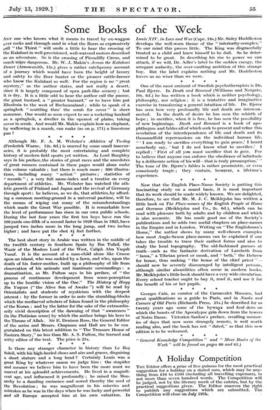Now that the English Place-Name Society is putting this fascinating
study on a sound basis, it is most important that its work should be made widely known. We are delighted, therefore, to see that Mr. M. J. C. Meiklejohn has written a little book on The Place-names of the English People at Home and Overseas (Meiklejohn and Co., 2s. 6d.), which can be read with pleasure both by adults and by children and which is also accurate. He has made good use of the Society's publications and he adds two useful chapters on place-names in the Empire and in London. Writing on "The Englishman's Home," the author shows by many well-chosen examples how most Anglo-Saxon place-names can be explained if one takes the trouble to trace their earliest forms and also to study the local topography. The old-fashioned guesses at truth—such as the fantastic derivation of Lambeth from " lama," a Tibetan priest or monk, and " beth," the Hebrew for house, thus making the house of the chief priest "- should now be severely discouraged by intelligent persons, although similar absurdities often occur in modern books. Mr. Mealejohn's little book should have a very wide circulation. Every school teacher ought to buy it, read it, and use it for the benefit of his or her pupas.
































 Previous page
Previous page